Hi i’m Imi Bassett and here’s my guest post on my mum’s BLOG!
Last Friday I decided to cook a three coursed meal for four people (Mum, Dad, Spare Granny Sasha and ME!)
I started off with a Spanish dish called Pan con tomate (bread with tomato in Spanish). This is a nice and easy dish all you need is tasty sourdough bread, garlic, tomatoes, olive oil and a pinch of salt. All you need to do is toast a slice of bread. Then whilst it is still warm rub a clove of garlic on it. After that squeeze the tomato on the bread and dispose the skins. Drizzle a small amount of olive oil over the top. Take a pinch of salt and sprinkle over the bread. HEY PRESTO!
YUM YOUR DONE!!!!
The next course is my signature dish! Corn chowder, it’s a lovely soup. The main ingredients are bacon, potatoes, corn, milk and, if you want it, smoked fish. My favourite corn chowder recipe is the one from my mum’s book! (MUM DID NOT MAKE ME WRITE THAT!)
The first time I made jellies I used Mum’s recipe but nowadays I play around with the flavours! This time it was tropical! I served it with frozen mango kebabs and home made smoothie!
Thanks Imi for your lovely post – here are a couple of the recipes for the pudding .
Imi’s Tropical Jelly (6-8)
5 sheets of gelatine
500 ml of whatever juice you like – Imi used a mango, banana, passionfruit juice (not too much pineapple in the mix or it won’t set properly)
Soak the sheets of gelatine in cold water, they will go soft and silky.
Make your smoothie or select your juice. It should taste sweeter than you would usually drink it because you will be serving it chilled.
Heat up about a 1/4 of the juice in a large saucepan, you don’t want it boiling – just hot. Remove the pan from the heat
Squeeze the cold water from the sheets of gelatine and drop them into the hot juice in the pan. Stir until the gelatine completely dissolves and disappears. Magic! Add the rest of the juice to the pan and give it all a stir.
Now, you choose, you can pour the jelly into moulds (metal are the best for turning out) to turn out later or simply serve this from glasses. Chill in the fridge for at least 6 hours and then serve.
Turning out your jellies
Carefully dip the jellies into a bowl of hot water, one at a time, taking care that the water doesn’t go in the jelly. The idea is to melt the very outside of the jelly. Turn the mould upside down on to a plate and WOBBLE it. If it won’t come out try dipping again.
Imi put some of her jelly into silicone fairy cake cases and served them straight from these, the jellies she turned out were in metal dariole moulds.
Tropical Banana Smoothie
1 mango (expertly peeled and chopped) + 1/4 banana + 1 cup pineapple chunks + pineapple juice to cover.
Whizz in the blender (we were borrowing a Nutribullet that worked brilliantly- may have to invest)
Imi did add 1 tsp honey as the pineapple was not quite sweet enough.
Imi’s “mango kebabs” – skewer cubes of mango onto cocktail sticks and freeze for about 2 hours.
Highlights:
Imi’s sense of achievement, a fantastic supper and her comment…….
When I’m a student I expect everyone will be saying “let’s go to Imi Bassett’s room for a chowder”










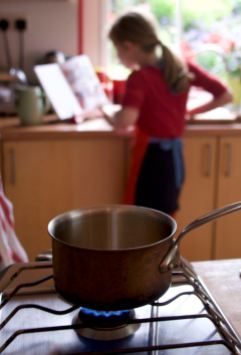









 140 g/5 oz chilled butter
140 g/5 oz chilled butter
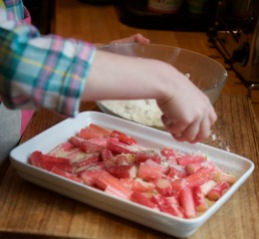



 Fruity Pancakes
Fruity Pancakes


















 Southern Indian Vegetables with Dal – Sambar
Southern Indian Vegetables with Dal – Sambar



























 200 g (ish) cherry tomatoes on the vine
200 g (ish) cherry tomatoes on the vine







